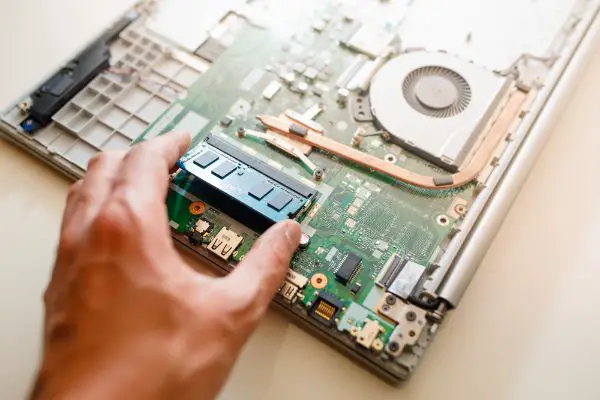Disclaimer: This post may contain affiliate links, meaning we get a small commission if you make a purchase through our links, at no cost to you. For more information, please visit our Disclaimer Page.
One of the easiest ways to upgrade your laptop’s performance is to add more RAM. If your laptop is running slow or you’re noticing frequent freezes and crashes, upgrading the RAM may help.
You should be able to upgrade the RAM on your laptop. It’s a simple process, and most laptops have a RAM slot on the underside of the chassis to install the new RAM module.
Table of Contents
Can I Add 8Gb Ram to a 4Gb Laptop?
You may wonder if you can add 8gb of ram to a 4gb laptop. The answer is yes, you can! However, you will need to purchase the additional ram and install it yourself. This process is not complicated, but it should only be done by someone who knows what they are doing.
If you are looking to add more ram to your laptop, there are a few things that you need to consider.
The first is the type of ram that your system uses. Most laptops use DDR SDRAM or DDR II SDRAM. If you want to add more than the standard amount of ram (usually around two gigabytes), you will need to upgrade to a newer type of memory, such as DDR III SDRAM.
The next thing you need to consider is whether your computer has an open slot for additional ram. Many laptops have one or two open slots, but some do not. If your computer does not have any open slots, you will need to purchase a new motherboard that supports more memory.
Once you have determined the type of ram you need and whether or not your computer has an open slot, you are ready to purchase the additional memory. You can find Ram for laptops online or at your local electronics store. Be sure to buy the same type of memory that your laptop already uses.
There are many benefits to adding more ram to your laptop. One advantage is that it can help increase the speed of your computer. If you are constantly multitasking or running programs that require a lot of memory, upgrading to more ram can help improve the overall performance of your system.
Additionally, adding more ram can help to reduce the amount of time it takes your computer to start up.
Another benefit of upgrading your ram is that it can improve the stability of your system. If you are running multiple programs at once, or if you tend to have a lot of tabs open in your web browser, having more memory can help prevent your system from crashing.
How do I Know if My Laptop Supports More than 4gb of Ram?
There are a few ways to determine how much RAM your laptop can support. One is to check the specifications or features listed on the manufacturer’s website.
Another way is to open up your laptop and look for the RAM modules. If you see two sticks of RAM, that means your laptop supports up to 16GB of RAM. If you only see one stick, it likely maxes out at either four or eight GB.
Finally, some software programs can also tell you how much memory your computer has and what type of RAM it uses.
If you’re not sure whether your laptop supports more than four gigabytes of memory, there are a few things you can do to find out:
- Check with the manufacturer’s website or documentation
- Open up your laptop and look at the RAM modules
- Use a software program to check your computer’s memory specs.
Now that you know how to check if your laptop supports more than four gigabytes of ram, you may wonder if it’s worth upgrading. Here are a few things to consider:
- How much extra RAM do you need?
- What will you be using your laptop for?
- Is there another bottleneck in your system?
If you’re a power user or gamer, upgrading to 16GB of RAM may be worth it. However, if you’re using your laptop for basic tasks, then four or eight GB may be plenty.
How Many Memory Slots Does My Laptop have?
You can usually find out how many memory slots your laptop has by looking at the specifications or taking a look inside. If you’re unsure where to find this information, you can try searching for your laptop model on the manufacturer’s website.
Once you know how many memory slots your laptop has, you can determine how much RAM you can upgrade to. Keep in mind that if your computer only has one memory slot, you’ll need to remove the old RAM before installing the new RAM.
Check your owner’s manual for more information on upgrading your laptop’s RAM.
How to know what kind of memory my laptop uses?
There are a few ways to determine the type of memory your laptop uses.
One way is to look at the specifications for your laptop or computer. This information will be listed under the “Memory” heading and should state what type of memory your device uses, such as SDRAM, DDR, or DDR-SDRAM.
Another way is to open up your computer and examine the RAM modules themselves. The most common types of memory are DIMMs (Dual Inline Memory Modules) and SO-DIMMs (Small Outline Dual Inline Memory Modules).
If you’re not sure how to identify these different types of memory, there are plenty of online resources that can help.
Finally, if all else fails, you can always contact your laptop’s manufacturer, and they should be able to tell you what kind of memory it uses.
Once you know what type of memory your laptop uses, the next step is to figure out how much memory it can hold. This information can also be found in your computer’s specifications or by contacting the manufacturer.
Most laptops come with at least one or two RAM slots, so if yours only has one slot, that’s probably all the memory it can hold. However, some laptops have multiple RAM slots and can be upgraded to accommodate more memory.
How to Add Additional Ram to my Laptop?
Before you begin, it’s important to know what type of RAM your laptop uses and how much RAM your laptop can support. We have discussed that in previous sections.
Once you have this information, follow these steps:
Shut down your computer and unplug all cords and accessories. Remove the battery from the back of the computer, if possible.
Flip over your computer and locate the panel that covers the RAM. There are usually screws on the back or bottom of the computer that holds the board in place.
Remove these screws and set them aside. Gently lift the panel and look at the RAM installed on your laptop. If you’re upgrading your RAM, you’ll need to remove the old modules and replace them with new ones.
Be very careful when removing or installing RAM modules, as they can be easily damaged. Hold on to each end of the module and push down until it pops out of its socket.
Line it up with the corresponding connector on the motherboard and press down until it clicks into place to install a new module.
Replace any screws that were removed earlier and reattach the battery cover. Plug in all cords and accessories, turn on your computer and check if the upgrade was successful.
If you’re not comfortable upgrading your laptop’s RAM yourself, you can always take it to a professional.
Upgrading RAM is a relatively straightforward process, but if something goes wrong, it’s good to have someone who knows what they’re doing there to help.


